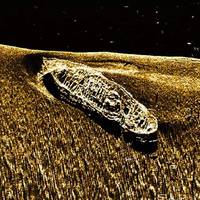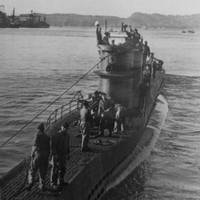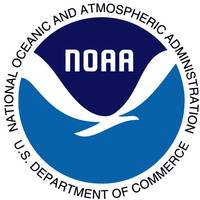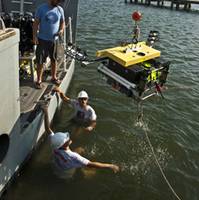Researchers to Visit ‘Battle of the Atlantic’ Wreckage

Researchers from the U.S. National Oceanic and Atmospheric Administration (NOAA) and its partners are set to visit what remains of two ships—a German U-boat and a Nicaraguan freighter – which sank off Cape Hatteras during World War II’s “Battle of the Atlantic,” which pitted the U-boats of the German navy against combined Canadian, British, and American forces defending Allied merchant ships. By July 1942, the United States had been in World War II for less than a year, but the fight was coming to the nation’s shores.
Historic WW I Shipwreck Survey Underway

Partnering U.S. agencies have commenced surveying the historic shipwreck of an American lightship shelled and sunk by a German U-boat during World War I nearly 100 years ago. Teams from the National Oceanic and Atmospheric Administration’s (NOAA) Monitor National Marine Sanctuary, in partnership with the U.S. Coast Guard (USCG) and the Bureau of Ocean Energy Management (BOEM), on Sunday, August 30, began a survey of the historic wreck of Diamond Shoal Lightship No. 71, the only American lightship to be sunk by enemy action during World War I.
WWII Wrecks Found off North Carolina

A team of researchers led by NOAA’s Office of National Marine Sanctuaries have discovered two significant vessels from World War II’s Battle of the Atlantic. The German U-boat 576 and the freighter Bluefields were found approximately 30 miles off the coast of North Carolina. Lost for more than 70 years, the discovery of the two vessels, in an area known as the Graveyard of the Atlantic, is a rare window into a historic military battle and the underwater battlefield landscape of WWII.
NOAA Honors Lost Crew of USS Monitor

Recreates faces of two sailors found in ill-fated ship’s gun turret, asks public for help to identify. Nearly 150 years after 16 USS Monitor sailors died when their vessel sank in a New Year’s Eve storm, NOAA’s Office of National Marine Sanctuaries has released forensic reconstructions of the faces of two crew members. Officials unveiled the reconstructions and dedicated a plaque in memory of the Monitor crew during a ceremony sponsored by the United States Navy Memorial Foundation at the Navy Memorial in Washington today.
NOAA launches USS Monitor Website

NOAA’s Office of National Marine Sanctuaries today launched a new website highlighting the 150-year history of the USS Monitor on the anniversary of the ship’s launch. The website, http://monitor.noaa.gov/150th, takes viewers from the iconic warship’s construction through its recovery to recent science expeditions undertaken to protect its legacy. The website, also offers students, teachers and history enthusiasts a variety of education materials and a calendar of upcoming events celebrating the Monitor.
WHOI Joins NOAA in "Battle of the Atlantic"

It’s been called everything from the Graveyard of the Atlantic to Torpedo Junction. By whatever name, the seas off the coast of North Carolina during World War II were the site of a devastating period for the United States, during which dozens of ships—mostly merchant vessels—were sunk by German U-Boats. Today, the remains of those ships, along with several U-Boats, rest at the bottom of the Atlantic. The National Oceanic and Atmospheric Administration (NOAA) estimates that from January to August 1942, more than 50 vessels were lost to the U-Boat assault.
NOAA, Navy Survey of Civil War Shipwrecks
NOAA and the U.S. Navy embarked today on a two-day research expedition to survey the condition of two sunken Civil War vessels that have rested on the seafloor of the James River in Hampton Roads, Va., for nearly 150 years. Using state-of-the-art sonar technology to acquire data, researchers will create three-dimensional maps of the two shipwrecks, USS Cumberland and CSS Florida, to analysis on their current conditions and better understand the technological innovations of the time. “The remains of the USS Cumberland and CSS Florida, preserved in the waters of Hampton Roads, remind us of the sacrifices made during the Civil War and give us a unique and rare opportunity to explore a pivotal chapter in our nation’s history…
Northrop Grumman Employees Help Identify USS Monitor Artifacts
identify artifacts recovered from the wreck of the USS Monitor. off the coast of Cape Hatteras, N.C. Atmospheric Administration (NOAA). high-energy X-ray machine. for ship construction. beneath decades of marine growth and encrustation. and a tread from the engine room floor. unit, who helped coordinate the X-ray efforts. and X-rays of the recovered items. The Monitor was the U.S. 9, 1862. history of The Mariners' Museum. and CEO John Hightower. Grumman Newport News for a neighbor and partner," said Dr. Broadwater, manager, NOAA Monitor National Marine Sanctuary Program. been invaluable in the complex process of analyzing Monitor artifacts. of designing and building nuclear-powered submarines. vessels. The Newport News sector employs about 18,000 people. from the USS Monitor.
NOAA & Navy to Begin Data Collecting Mission on Ironclad Ship Monitor
In an effort to begin stabilizing the deteriorating hull of U.S.S. Monitor, the sunken Civil War ironclad ship off Cape Hatteras, N.C., the National Oceanic and Atmospheric Administration (NOAA) and the U.S. Navy will undertake a data-collection mission to assess what needs to be done. This archaeological and engineering mission will take place at the Monitor National Marine Sanctuary, which was established in 1975 to provide protection for the ship. The mission is sponsored by NOAA, the Navy, and The Mariners' Museum. "Mission goals include surveying and assessing Monitor's lower hull, assessing the feasibility and difficulty of removing the steam engine…
NOAA, Navy Raise Turret of USS Monitor
NOAA and the U.S. Navy have succeeded in raising the world’s first armored revolving gun turret from the wreck of the famous Civil War ironclad USS Monitor, which rests below 240 feet of water 16 miles southeast of Cape Hatteras, N.C., in the “Graveyard of the Atlantic.” Also recovered today were the vessel’s two large Dahlgren cannons. Yesterday’s retrieval of the turret and cannons marks the end of a multi-year effort by NOAA, the Navy and The Mariners’ Museum to preserve key components of the revolutionary ship before sea water corrodes the vessel beyond recognition. The turret, with the cannons inside, was hoisted from the sea floor by a 500-ton crane aboard the Derrick Barge Wotan, owned and operated by Manson Gulf Industries.
NOAA Launches New Marine Science Portal
View of the USS Monitor wreck, which sank on Dec. 31, 1862, and now teams with marine life. NOAA and Immersion Presents launched oceanslive.org, a marine science portal that offers live video and special content to educate people of all ages about the ocean, including national marine sanctuaries. Immersion Presents is an after-school science education program founded by ocean explorer Robert Ballard. "NOAA is excited to offer this dynamic Internet-based resource, which will allow students, educators and the public to share in the thrill of discovery while learning more about the natural and cultural treasures of our national marine sanctuaries and the underwater world," said NOAA National Marine Sanctuary program director Daniel J. Basta.
NOAA, Navy Raise Turret of USS Monitor
NOAA and the U.S. Navy have succeeded in raising the world's first armored revolving gun turret from the wreck of the famous Civil War ironclad USS Monitor, which rests below 240 ft. of water 16 miles southeast of Cape Hatteras, N.C., in the "Graveyard of the Atlantic." Also recovered were the vessel's two large Dahlgren cannons. Yesterday's retrieval of the turret and cannons marks the end of a multi-year effort by NOAA, the Navy and The Mariners' Museum to preserve key components of the revolutionary ship before sea water corrodes the vessel beyond recognition. The turret, with the cannons inside, was hoisted from the sea floor by a 500-ton crane aboard the Derrick Barge Wotan, owned and operated by Manson Gulf Industries.






